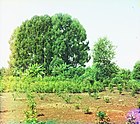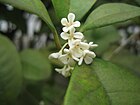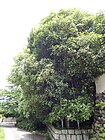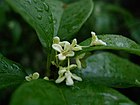Note: This is a project under development. The articles on this wiki are just being initiated and broadly incomplete. You can Help creating new pages.
Osmanthus fragrans - Fragrant olive
Fragrant olive is a species native to Asia from the Himalayas through southern China to Taiwan and southern Japan and southeast Asia as far south as Cambodia and Thailand.
Contents
[hide]- 1 Uses
- 2 Parts Used
- 3 Chemical Composition
- 4 Common names
- 5 Properties
- 6 Habit
- 7 Identification
- 8 List of Ayurvedic medicine in which the herb is used
- 9 Where to get the saplings
- 10 Mode of Propagation
- 11 How to plant/cultivate
- 12 Commonly seen growing in areas
- 13 Photo Gallery
- 14 References
- 15 External Links
Uses
Carbuncles, Boils, Whoping cough, Retinitis pigmentosa, Dysmenorrhoea, Rheumatism, Bruises.
Parts Used
Chemical Composition
The content of 1,3,5-Trioxepane was the highest in Latifolius group, accounting for 22.69 %. Ketones, alcohols, asters, aldehydes and acids.[1]
Common names
| Language | Common name |
|---|---|
| Kannada | |
| Hindi | Silang |
| Malayalam | |
| Tamil | |
| Telugu | |
| Marathi | NA |
| Gujarathi | NA |
| Punjabi | NA |
| Kashmiri | NA |
| Sanskrit | Brihat bakula, Vasuka |
| English | Fragrant Olive, Sweet osmanthus |
Properties
Reference: Dravya - Substance, Rasa - Taste, Guna - Qualities, Veerya - Potency, Vipaka - Post-digesion effect, Karma - Pharmacological activity, Prabhava - Therepeutics.
Dravya
Rasa
Tikta (Bitter), Kashaya (Astringent)
Guna
Laghu (Light), Ruksha (Dry), Tikshna (Sharp)
Veerya
Ushna (Hot)
Vipaka
Katu (Pungent)
Karma
Kapha, Vata
Prabhava
Habit
Identification
Leaf
| Kind | Shape | Feature |
|---|---|---|
| Simple | Opposite | Leaves are leathery, lustrous, dark green leaves 2-5 in. long; finely dentate or entire |
Flower
| Type | Size | Color and composition | Stamen | More information |
|---|---|---|---|---|
| Unisexual | 2-4cm long | White | 5-20 | Very fragrant, small white flowers in fall and some flowers in early spring |
Fruit
| Type | Size | Mass | Appearance | Seeds | More information |
|---|---|---|---|---|---|
| Drupe | 1.5-3 | Fruit coulor is purple | Many | {{{6}}} |
Other features
List of Ayurvedic medicine in which the herb is used
Where to get the saplings
Mode of Propagation
How to plant/cultivate
Easily grown in any well-drained soil in sun or part shade, but flowering more freely in a sunny position.[3]
Commonly seen growing in areas
Mountain areas, Himalayas, Forests.
Photo Gallery
References
External Links
- Ayurvedic Herbs known to be helpful to treat Carbuncles
- Ayurvedic Herbs known to be helpful to treat Boils
- Ayurvedic Herbs known to be helpful to treat Whoping cough
- Ayurvedic Herbs known to be helpful to treat Retinitis pigmentosa
- Ayurvedic Herbs known to be helpful to treat Dysmenorrhoea
- Ayurvedic Herbs known to be helpful to treat Rheumatism
- Ayurvedic Herbs known to be helpful to treat Bruises
- Herbs with Fruits used in medicine
- Herbs with common name in Hindi
- Herbs with common name in Sanskrit
- Herbs with common name in English
- Habit - Evergreen shrub
- Index of Plants which can be propagated by Seeds
- Index of Plants which can be propagated by Cuttings
- Herbs that are commonly seen in the region of Mountain areas
- Herbs that are commonly seen in the region of Himalayas
- Herbs that are commonly seen in the region of Forests
- Herbs
- Ayurvedic herbs that don't have flower, fruit and leaf photos
- Ayurvedic herbs that don't have seed photos
- Oleaceae









